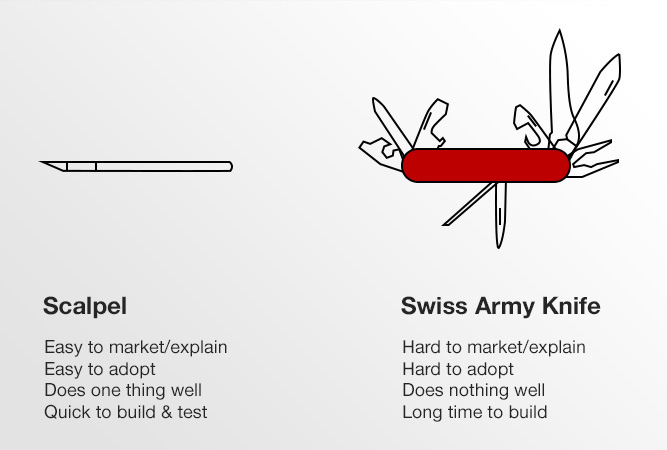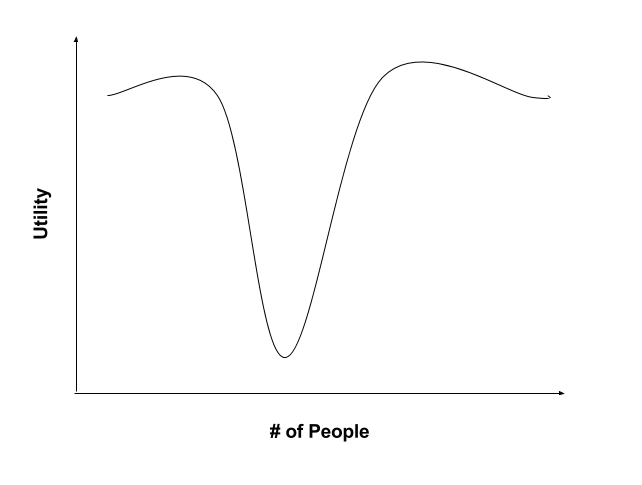In Jeff Bezos’ annual letter to shareholders last week, he proclaimed, “The outside world can push you into [stasis and irrelevance] if you won’t or can’t embrace powerful trends quickly. If you fight them, you’re probably fighting the future. Embrace them and you have a tailwind.” So, what are the world’s trends in sales right now, and importantly, which trends will help you move faster than ever before?
Increased Specialization in Sales Organizations
Recently many of the most successful sales organizations have greatly increased the specialization within their teams, leading to two primary sales roles: prospectors and closers. Prospectors are focused on the laborious process of generating new leads and qualifying them through the pipeline. Closers then take qualified leads off the hands of prospectors and in turn focus on converting qualified leads into new deals.
An increase in sales specialization is evident by simply investigating the Google search traffic for the keyword “Sales Development Representative” (SDR), an entry-level position that specializes in outbound prospecting and qualifying new leads. Over the past five years, the search traffic for this keyword has more than tripled:

As a consequence of increased sales specialization, the day-to-day activities of sales roles have become more repetitive and metrics-driven. For example, it is typical for an SDR to spend the overwhelming majority of their time completing just two tasks: manually researching and writing cold emails to an average of 265 new sales prospects every month (The Bridge Group 2016). Once the SDR is able to get a prospect on the phone for a certain number of minutes, the potential new customer is then handed off to a closer, typically known as an “Account Executive” (AE), who is paid for their number of deals closed. This rigorous approach of separating the sales prospecting and closing responsibilities has lead to more efficient teams and increased profits for all who have adopted the strategy.
But how can a modern sales team squeeze-out even more efficiency once all of the responsibilities are divided? The future is trending towards sales processes that make extensive use of their data to achieve dramatically better results, and the winds are picking up strongly. To paraphrase from Jeff Bezos’ annual letter once again:
We’re in the middle of an obvious trend right now: machine learning and artificial intelligence… Though less visible, much of the impact of machine learning will be quietly but meaningfully improving core operations.
In the context of sales, there are a number of time-consuming operations and outreach tasks where Bezos’ prediction applies: obtaining prospects, outreach via cold emails and cold phone calls, coordinating product demonstrations, and completing the onboarding process. Data and machine learning is already helping salespeople gain insights to be even more effective in each of these fundamental sales tasks. Let’s have a look.
Here are a few of the leading startups building sales productivity software:
Obtaining Prospects
Finding new leads has come a long way from paging through the phone book. Today, dozens of companies provide lists of high quality leads for purchase. 6sense, Data.com, and GrowBots are leading solutions that help sales teams obtain the contact information of in-market buyers.
Outreach
Establishing candid rapport with a stranger over email or phone call is among the most difficult of sales tasks to consistently complete successfully. In the past, only true sales grandmasters have risen to the top in this cutthroat activity. Fortunately, there are promising new products in this category that help build relationships during the outreach process, which is often referred to as “lead nurturing”.
For sales teams who are comfortable practicing a spray and pray approach, products like Outreach.io, SalesLoft, and Prospect.io have emerged as major players that help SDR’s automate outreach efforts. More recent entrants to the market have been focused on bringing much-needed context and personalization to outreach efforts. For example, sales teams using copywriters from Cavalry are able to get highly engaging cold emails written quickly.
Coordinating Demo’s
Once a qualified prospect is finally on the hook, it’s critical to not let the logistics of a test drive get in the way of closing a sale. Time saved for the prospect and AE is a win-win, so here are a few tools that have become go-to solutions for handling the demo process from start to finish: Calendly and Clara are automated scheduling assistants that make finding a convenient time painless. ClearSlide goes one step further by providing sales teams with insights into how their prospects are engaging with the demo experience.
Onboarding
Finally, once the sale is closed the onboarding process begins as the last remaining sales task. Appcues helps with onboarding by making it easy to implement a tour of an application’s features. Next, Drift and Intercom help companies automatically communicate with their customers in a way that is personalized to their usage of the product, leading to increased engagement and reduced churn.
What’s next?
While the influx of sales productivity software makes it easy to believe that the trend of sales software is pointing towards total human-replacement, I think that is the wrong conclusion to take away. In sales, the most appropriate applications of technology like artificial intelligence or machine learning will be the tools that enable more personal touches, better research, and more face time ? while removing needless overhead costs and administrative tasks.
Technology works best when it helps humans to mechanize a repetitive process so that they can do even more. Which software will you make use of to help you and your team achieve even better results? As Bezos says, embrace these new tools and the world’s trends will be your tailwinds, if not, you’re probably fighting the future.






